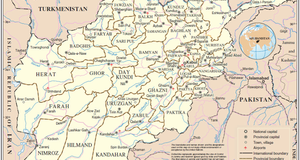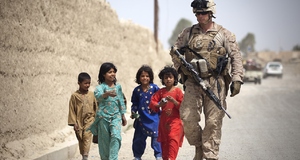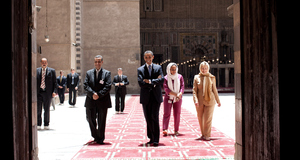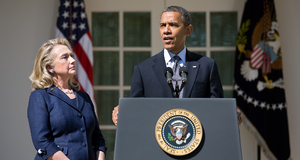The Obama PresidencyZarb-e-Azb: The Obama Administration's Response to the Haqqani Network and the Relationship with Pakistan
By
2015, Vol. 7 No. 02 | pg. 3/3 | « Strategies for the FutureGiven the Pashtun region’s historical independence, there is little reason to expect that the population would take well to centralized government rule. The Haqqani network has acted as a quasi-governmental institution, even providing for services such as policing, tax offices, courts, recruiting centers and medical care 52. The Haqqani understanding of the tribal regions and psyche is critical to stability in the region, and thus, must be controlled in proper manner. Jalaluddin Haqqani’s experience as the Minister of Tribal Relations offers great knowledge and experience with the social norms and tendencies of the highland Pashtun people53. These people are largely misunderstood as the culture of highland Pashtuns is vastly different from non-Pashtuns and lowland Pashtun people54. The highland Pashtun people are fiercely independent and do not have the same economic sustainability and access to arable farmland. These major economic differences have led to significant societal differences among the Pashtun people, resulting in the inability of any country to be successful in incorporating the entirety of the Pashtun region into their governance. The marginalized highland Pashtuns have thus been given significant autonomy, with governments such as Afghanistan, Pakistan and Britain adopting what Thomas Barfield calls a “swiss-cheese model”55. This allows the centralized governments to controls, tax and rule over the lowland, prosperous regions, largely leaving the highland areas to their own devices. This has led to numerous problems in these tribal areas, notably militant insurgent activity, poverty, famine and illiteracy. With the advent of modern technology, the ability to govern and support the tribal areas will only become easier. Villages which were previously only accessible by what essentially amount to goat paths can be accessed by aircraft, roads can be built around and through the rough terrain around the Durand Line, allowing the Pakistanis more ease of governance. The Pakistanis and the United States must exploit the increasing access to these areas to contribute aid in the form of funding for infrastructure projects, education, medical and social services. With a literacy rate of 17% for men and 1% for women, the population is vulnerable to the influences of the militant organizations and their radical interpretations of the Koran.History supports that the Haqqanis serve as paramilitaries of sorts, operating as an extra-governmental body for violent projections of power. They have made themselves available to those who funnel money and weapons to their madrassas, camps and bases. Despite the bleak outlook, it is not entirely unfeasible to suggest that Pakistan, Afghanistan, and even the United States could work with the Haqqanis to maintain autonomy in the FATA 56. However, the arrest of Ibrahim Haqqani and rise of Sirajuddin makes the likelihood of a peaceful end more and more unlikely. Families and tribes in the FATA had tended to support the Haqqanis, especially considering the family nature of the group, however, growing violence, and indiscriminate targeting is slowly alienating the Pashtun people and providing support for U.S. and Pakistani offensives in the area. The Haqqani relationship with the Pakistani government shows it is willing to cooperate with governments, although likely less so with the West. The expertise of the Haqqanis at navigating the difficult relationship between tribes is shown not only in his success as a militant commander, but in his appointment as the Minister of Frontier and Tribal Affairs under the Taliban. He used this appointment to continue to win over the remaining ethnic groups that had not supported him yet in Eastern Afghanistan57. Negotiation and reasonable settlement of the conflict will only get harder as Sirajuddin, the son of Jalaluddin has assumed control over the Nexus in recent years. Sirajuddin is decidedly more radical in his theology and promotion of Islamist government in Afghanistan, Pakistan, and abroad58. This could cause issues especially with United States and Western relations in Pakistan, Afghanistan, and hopefully an increased government presence in the FATA. With this change in ideology, one question is whether the solution is even feasible, however, as the Haqqani’s have shown interest in coming to negotiation tables with the Taliban and al-Qaeda, it is certainly possible. This would likely be the fastest method of bringing stability to the region as the relationships and quasi-government structure is already in place. Alternatively, United States foreign aid to Pakistan revolves almost solely around military aid. The influence the United States has over Pakistan militarily is huge, and Operation Zarb-e-Azb likely would not have happened without the prodding of the U.S. government. Military operations such as Zarb-e-Azb, combined with drone strikes and special operations raids has the vast majority of the population resenting the governments of Islamabad, Kabul, and Washington. The United States would do well to realign their appropriations to Pakistan and to the region in general. The Center for American Progress looked into American foreign aid to FATA, discovering that of the $5.8 billion appropriated to FATA, 96% goes directly to military operations and only 1% is directed towards development59. Low literacy rates, poor medical care and nearly no other social services makes the population an easy target for anti-Pakistan, Afghanistan and U.S. propaganda60. The Haqqanis have established some extent of social services through their network of 84 madrassas throughout North Waziristan. With the monopoly of education in the area, Haqqanis can promote the ideology, which they and their allies ascribe to, giving them massive power over the thoughts and minds of the Pashtun population. Chances are this would take a significant amount of time. In the thirteen years the United States has been in Afghanistan, there is still much to be accomplished with infrastructure development even when receiving billions in funding. While this would be the most beneficial method of dispelling insurgency and installing stability in the region, it would involve a change of cultural distrust of centralized government the Pashtun people have possessed for ages. Needless to say, the greatest good comes with the greatest difficulty and time investment. The United States cannot promote a solution to the insurgency in Waziristan without an effort to promote development in the region. The lack of infrastructure is a concerning prospect and one which leads to easy recruitment for militant groups. Military action by western countries has created resentment for government even more deep than was there historically. As long as the people of Waziristan are illiterate, impoverished, hungry, and influenced by militant propaganda, they will continue to fight the coalition and the centralized Pakistani government if they attempt to remove some autonomy from the FATA. Endnotes1.) Brown, Vahid; Rassler, Don. Fountainhead of Jihad: The Haqqani Nexus, 1973-2012 Oxford University Press. Kindle Edition. 2.) Dressler, Jeffery. The Haqqani Network. Institute for the Study of War. Institute for the Study of War. 5 Sept 2012. Web. 5 Oct. 2014 3.) Ibid 4.) Dreazen, Yochi. “The New Enemy in Afghanistan”. National Journal. 14 July 2011. Academic OneFile. Web. 28 Oct. 2014. 5.) Dreazen, Yochi. “The New Enemy in Afghanistan”. National Journal. 14 July 2011. Academic OneFile. Web. 28 Oct. 2014. 6.) Dressler, Jeffery. The Haqqani Network. Institute for the Study of War. Institute for the Study of War. 5 Sept 2012. Web. 5 Oct. 2014 7.) Ibid 8.) Brown, Vahid; Rassler, Don. Fountainhead of Jihad: The Haqqani Nexus, 1973-2012. 2013. Oxford University Press. Kindle Edition. 9.) Dressler, Jeffery. The Haqqani Network. Institute for the Study of War. Institute for the Study of War. 5 Sept 2012. Web. 5 Oct. 2014 10.) Dreazen, Yochi. “The New Enemy in Afghanistan”. National Journal. 14 July 2011. Academic OneFile. Web. 28 Oct. 2014. 11.) Dressler, Jeffery. The Haqqani Network. Institute for the Study of War. Institute for the Study of War. 5 Sept 2012. Web. 5 Oct. 2014 12.) Ibid 13.) Brown, Vahid; Rassler, Don. Fountainhead of Jihad: The Haqqani Nexus, 1973-2012. 2013. Oxford University Press. Kindle Edition. 14.) Dressler, Jeffery. The Haqqani Network. Institute for the Study of War. Institute for the Study of War. 5 Sept 2012. Web. 5 Oct. 2014 15.) Siddiqa, Ayesha. “Jihadism in Pakistan: The Expanding Frontier.” Journal of International Affairs 63.1 (2009): 57+. Academic OneFile. Web. 10 Oct 2014. 16.) Ibid. 17.) Brown, Vahid; Rassler, Don. Fountainhead of Jihad: The Haqqani Nexus, 1973-2012. 2013. Oxford University Press. Kindle Edition. 18.) Petrou, Michael. “With Friends Like These, Who Needs…” Maclean’s 124.40. 17 Oct. 2011. 38+. Academic OneFile. Web. 10 Oct. 2014. 19.) Brown, Vahid; Rassler, Don. Fountainhead of Jihad: The Haqqani Nexus, 1973-2012. 2013. Oxford University Press. Kindle Edition. 20.) Ibid 21.) Arif Jamal, Shadow War: The Untold Story of Jihad in Kashmir, Brooklyn, NY: Melville House, 2009, p. 110. Brown, Vahid; Rassler, Don (2013-02-01). Fountainhead of Jihad: The Haqqani Nexus, 1973-2012 (Kindle Location 4329). Oxford University Press. Kindle Edition. 22.) Coll, Steve. “Anatomy of a Victory: CIA’s Covert Afghan War.” Global Issues. Washington Post, 19 July 1992. Web. 28 Oct. 2014. 23.) “Foreign Military Financing Account Summary.” U.S. Department of State. U.S. Department of State, n.d. Web. 28 Oct. 2014. 24.) Dreazen, Yochi. “The New Enemy in Afghanistan”. National Journal. 14 July 2011. Academic OneFile. Web. 28 Oct. 2014. 25.) Dreazen, Yochi. “The New Enemy in Afghanistan”. National Journal. 14 July 2011. Academic OneFile. Web. 28 Oct. 2014. 26.) Joshua White, Pakistan’s Islamist Frontier: Islamic Politics and U.S. Policy in Pakistan’s North-West Frontier, Arlington, VA: Center on Faith & International Affairs, 2008, p. 26 Brown, Vahid; Rassler, Don (2013-02-01). Fountainhead of Jihad: The Haqqani Nexus, 1973-2012 (Kindle Locations 4541-4543). Oxford University Press. Kindle Edition. 27.) Brown, Vahid; Rassler, Don (2013-02-01). Fountainhead of Jihad: The Haqqani Nexus, 1973-2012 (Kindle Locations 1003-1004). Oxford University Press. Kindle Edition. 28.) Doc. No. AFGP-2002-008588-13. Combating Terrorism Center. West Point n.d. Web. 25 Oct. 2014 29.) Dressler, Jeffery. The Haqqani Network. Institute for the Study of War. Institute for the Study of War. 5 Sept 2012. Web. 5 Oct. 2014 30.) Siddiqa, Ayesha. “Jihadism in Pakistan: The Expanding Frontier.” Journal of International Affairs 63.1 (2009): 57+. Academic OneFile. Web. 10 Oct 2014. 31.) Petrou, Michael. “With Friends Like These, Who Needs…” Maclean’s 124.40. 17 Oct. 2011. 38+. Academic OneFile. Web. 10 Oct. 2014. 32.) Ibid. 33.) Curtis, Lisa. “Should the United States Cut off Aid to Pakistan?” The Heritage Foundation. The Heritage Foundation, 5 Aug. 2011. Web. 03 Nov. 2014. 34.) Cookman, Colin. “The Limits of U.S. Assistance to Pakistan.” Center for American Progress. Center for American Progress, 18 July 2011. Web. 03 Nov. 2014. 35.) Ibid 36.) Curtis, Lisa. “Should the United States Cut off Aid to Pakistan?” The Heritage Foundation. The Heritage Foundation, 5 Aug. 2011. Web. 03 Nov. 2014. 37.) Cookman, Colin. “The Limits of U.S. Assistance to Pakistan.” Center for American Progress. Center for American Progress, 18 July 2011. Web. 03 Nov. 2014. 38.) Ibid 39.) Ibid 40.) Ibid 41.) "Blacklisted; The Haqqani network."The Economist15 Sept. 2012: 38(US).Academic OneFile. Web. 5 Nov. 2014. 42.) 112-168, 112th Cong., 126 Stat. 1299 GPO (2012)(enacted). 43.) "Blacklisted; The Haqqani network."The Economist15 Sept. 2012: 38(US).Academic OneFile. Web. 5 Nov. 2014. 44.) Dreazen, Yochi. “The New Enemy in Afghanistan”. National Journal. 14 July 2011. Academic OneFile. Web. 28 Oct. 2014. 45.) Petrou, Michael. “With Friends Like These, Who Needs…” Maclean’s 124.40. 17 Oct. 2011. 38+. Academic OneFile. Web. 10 Oct. 2014. 46.) Dreazen, Yochi. “The New Enemy in Afghanistan”. National Journal. 14 July 2011. Academic OneFile. Web. 28 Oct. 2014. 47.) Brown, Vahid; Rassler, Don. Fountainhead of Jihad: The Haqqani Nexus, 1973-2012. Oxford University Press. Kindle Edition. 48.) Ibid 49.) Bergen, Peter. The Year of the Drone. The New America Foundation. 24 Feb. 2010. Web. 10 Oct. 2014. 50.) Drone Wars Pakistan: Leaders Killed. The International Security Project. The New America Foundation. N.d. Web. 5 Oct. 2014. 51.) Bergen, Peter. The Year of the Drone. The New America Foundation. 24 Feb. 2010. Web. 10 Oct. 2014. 52.) Rassler, Donald, and Vahid Brown. The Haqqani Nexus and the Evolution of Al Qaeda. 13 Jul. 2011. Combating Terrorism Center. Web. 1 Nov. 2014 53.) Dreazen, Yochi. “The New Enemy in Afghanistan”. National Journal. 14 July 2011. Academic OneFile. Web. 28 Oct. 2014. 54.) Brown, Vahid; Rassler, Don (2013-02-01). Fountainhead of Jihad: The Haqqani Nexus, 1973-2012. Oxford University Press. Kindle Edition. 55.) Ibid 56.) Mir, Amir. “How Haqqanis Escaped the U.S. Terror List.” DNA Syndication [Mumbai]. 17 Oct. 2011. N. pag. Web. 28 Oct. 2014. 57.) Brown, Vahid; Rassler, Don (2013-02-01). Fountainhead of Jihad: The Haqqani Nexus, 1973-2012 (Kindle Locations 933-934). Oxford University Press. Kindle Edition. 58.) "The Haqqani Network, a family and a terror group." CNN Wire. LexisNexis Academic. 8 Sept. 2012. Web. 1 Nov. 2014. 59.) “U.S. Aid to Pakistan by the Numbers.” Center for American Progress. Center for American Progress. 21 Aug 2008. Web. 01 Nov. 2014. 60.) Ibid. Suggested Reading from Inquiries Journal
Inquiries Journal provides undergraduate and graduate students around the world a platform for the wide dissemination of academic work over a range of core disciplines. Representing the work of students from hundreds of institutions around the globe, Inquiries Journal's large database of academic articles is completely free. Learn more | Blog | Submit Latest in International Affairs |


















